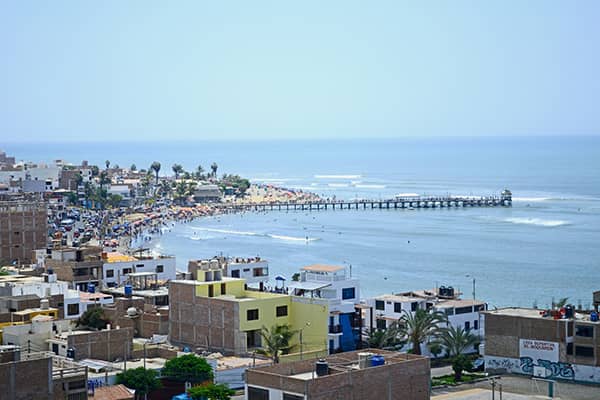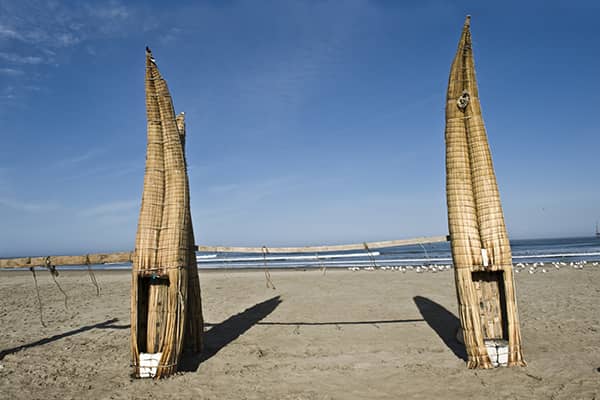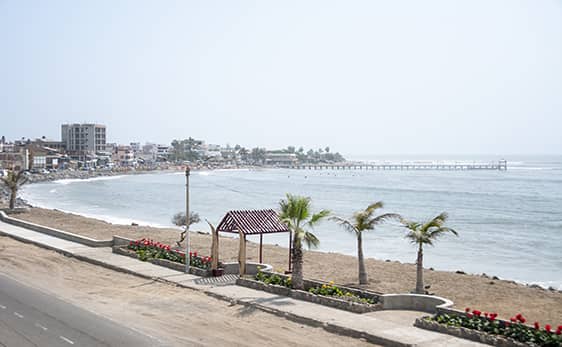By Steve LePoidevin
Only a little more than an hour’s flight north of Lima, Huanchaco is a world away from the noise and pollution of the capital city. This small coastal fishing village has long been a destination for international surfers because of its year-round surf that caters to all levels. The waves close to shore are gentle enough for beginners but experienced surfers can head further out to catch the larger swells.
Apart from a few newer apartment buildings and restaurants, the town has not changed much over the decades. Every morning, fishermen head out to sea in small hand-crafted boats that are made from reeds grown in the nearby protected marsh. It’s not unusual to see them mending their nets in front of their homes during the day.
My wife, Nancy, and I had picked Arequipa as our home base when we first moved to Peru several years ago. While on an exploratory trip up the coast during our first year we fell in love with the small town of Huanchaco. Sitting outside the only real beach bar in town looking out at the crashing surf and groups of kids playing in the sand, we decided then and there that “we could live here!” Six months later, we packed up our life in Arequipa (four suitcases and two carry-ons) and traveled north.
Although the population is approaching 70,000, most of the activity and businesses are concentrated in the small traditional beachside section of the town. This is what tourists and residents have in mind when they describe Huanchaco. Geographically the town stretches for quite a distance in all directions.
It takes a little more than an hour to walk the length of the beach and back to where you started. And the beach runs adjacent to the main road through Huanchaco from one end to the other.
As one person said, “You don’t come to Huanchaco to do stuff…you come here to do nothing!” It has been a popular vacation destination for Peruvians for decades. They come to enjoy the fresh seafood, relax on the beach or try their hand at surfing with one of the many surfing schools in town.
Although the surf seems to spit up a new batch of rocks and pebbles every morning onto the sand in front of the town, vast stretches of pristine smooth sandy beach are only a few minutes’ drive or walk north or south.
The best part about Huanchaco is that it is only 15 minutes from the large city of Trujillo where you can find all the amenities you need. Colorful buses ply back and forth between the two places several times an hour and there are always taxis available. The bus costs less than a dollar and a taxi to anywhere in the city will be less than $10.
Huanchaco is one of those few places where you can live for less than $1,000 per month. Of course, traveling, bar hopping, and dining out on a regular basis will increase this. But your basic expenses…food, rent, and utilities…can definitely be covered. There are plenty of inexpensive rentals, furnished and unfurnished, and apartments can be purchased from $50,000 upwards.
The climate is perfect! Temperatures hover around 70 F most of the year plus or minus ten degrees. The mercury might reach 80 F on a hot summer day and dip into the high 50s F in the middle of a cool winter night. No air conditioning or central heating is necessary. And it never rains…less than an inch a year.
It’s easy to appreciate that there are no bugs except the odd housefly or beetle; windows and doors can be left wide open all day. You will rarely, if ever, see a mosquito.
Five Reasons to Move to Huanchaco, Peru

1. You are Looking for a Cheap Place to Live
It is impossible to beat the cost of living in Peru’s small towns and Huanchaco is no exception. Use your pocket change to shop at the small central market or buy from one of the many street vendors. Fresh fruits, veggies, and meats are all available for a fraction of what you would pay in most parts of North America. For those that can’t go without their imported goods, Trujillo’s large malls and grocery stores are only a short drive or taxi ride away.
2. You’ve Always Wanted to Be a Beach Bum
Huanchaco is a laidback place. For most of the year, sandals, shorts, and t-shirts (or no shirt) are the clothing of choice. During the cooler winter months, light jackets or long trousers might be necessary for a couple of days a week. You can wear whatever you want, and nobody will give you a second glance.
Tourists and expats tend to frequent the small bars and clubs scattered along the beach road but locals buy beer from one of the many bodegas and sit on small stools outside the shops. The latter is the best way to learn the local gossip and practice your Spanish. If you are not comfortable with being lazy, it is not the place for you!
3. Live in a World-Class Surfing Destination Without the Crowds
If you don’t already know how to surf, you are never too old to begin. It is the number one attraction in town and many residents of all ages hit the waves every day all year. Numerous surfing schools throughout the town offer a variety of beginner and advanced courses. Or you can just rent a board and a wetsuit for the day and try it by yourself.
Unlike many other surfing destinations, you won’t have to fight for space or the next big wave. Surfers confer with each other about the best spots and spread themselves out accordingly.
During the year, several large surfing championships are held at the local beach. These make for great photo-ops and souvenir t-shirt shopping.
4. Enjoy Life in a Small Traditional Beach Town Only Minutes From a Modern City
Living in Huanchaco is like going back in time, way back in time! There is nothing modern about the place. Most residents shop daily at the local market. Numerous vendors ride their three-wheeled vehicles through town selling everything from cleaning supplies to fresh milk to fruit and vegetables. Kids play on the streets. Fishermen mend their nets outside or craft new reed boats during the day. There are few vehicles once you get off the main beach road.
Anytime a new building is being constructed, trucks dump their loads of sand and gravel in the middle of the street…nobody has a yard. Until the building is completed, the rest of us have to drive around the piles or choose an alternate route.
But jump into a taxi and you are in the center of Trujillo within 15 or 20 minutes. This city of almost one million residents has all the modern amenities you will ever need, including all the popular fast-food American restaurants for those times you crave a taste of home.
5. You Hate Rain
Coastal Peru is one of the world’s driest areas. In Huanchaco, less than an inch of rain falls every year. You can almost count the raindrops in the rare showers that barely moisten the pavement and rarely last more than five minutes. It is not unusual to go for months without a drop of precipitation. But the flip side is the dust which covers every surface with a fine film on a daily basis.
Things to Do in Huanchaco, Peru

Watch the Sunset
The sunsets are spectacular! Residents and tourists alike gather on the beach every evening to watch the show. Another popular spot to take in the sight is from the large wooden pier that juts out into the water from the town center. Once the main harbor for nearby Trujillo, it now acts as a backdrop to the thousands of tourist photos taken every year.
Dine on the Town’s Claim to Fame
Huanchaco is famous for its inexpensive seafood restaurants that line the beach. Visitors from Trujillo and the surrounding countryside flock to the beach and restaurants on the weekends to feast on traditional dishes, the most popular being ceviche.
Many consider Huanchaco to be the birthplace of this traditional Peruvian dish. It is typically made from fresh raw fish cured in citrus juices and spiced with chili peppers, onions, and coriander. Every establishment has their own recipe and their favorite fish for this famous dish.
Some say ceviche dates back to the 2,000-year-old Moche civilization when fish was marinated in the juice of the local banana passion fruit or the Incas, when the fermented Andean beverage, chicha, was used. But it is more probable that the ceviche served today originated during Spanish colonial times.
Feast on the Local Street Food
It’s hard to resist the street food that shows up every afternoon and evening in the area opposite the large pier. The scent of spicy barbequed meats and sausages lets everybody know that it’s time to start snacking.
Peru’s answer to the donut is the picarone. These are discs of fried dough covered in sweet cane syrup. But the “dough” is made from a combination of squash and sweet potato! Another favorite is papas rellenas, meat-stuffed potatoes.
The all-time favorite street food in Peru is antichuchos. These skewers of pieces of marinated-cow heart are found throughout the country. Grilled on an open flame and smothered in the vendors’ secret spices as they sizzle, they are an addiction for many Peruvians!
Take a Surfing Lesson
There are many surfing schools in town. Most classes include time in the classroom where you will be shown the proper techniques, find out whether you are a right-handed or left-handed surfer, and be fitted with a wetsuit and board. Then it is off to the beach for an hour or so.
Generally, the instructor will be in charge of a handful of beginners in the water. You’ll start by being pushed off the small waves by the instructor. This gives you a chance to just try standing on the board as you glide along. You’ll slowly be moved to larger waves where you can attempt the process on your own. Most classes guarantee that you won’t have to pay if you don’t stand up!
Courses are available for all levels from beginner to advanced.
Video: Sun, Surf, and Ceviche in Huanchaco, Peru

Ever since Hiram Bingham brought the famous Inca citadel of Machu Picchu to the world’s attention in 1911, growing numbers of tourists have visited Peru each year. But few visitors venture to the north coast where other spectacular archaeological sites await along with large expanses of sandy beach, world-renowned surf, and excellent seafood.
The small fishing/surfing town of Huanchaco is located 300 miles north of Lima. Only minutes away from the bustling city of Trujillo, the third largest in the country, it boasts an inexpensive cost of living and laid-back lifestyle. Huanchaco is worth a look as a retirement location for those seeking a tranquil beach town.
For most of the year, temperatures hover around the low to mid 70s and rainfall is pretty much non-existent. Springtime starts in early September, but the winter months (June—August) can sometimes feel like a chilly U.S. autumn and temperatures can dip into the mid 60s. But even during these cooler months, you will still get two or three days of warm sunshine every week.
During the peak summer months of January and February, Huanchaco swells in size as the tourist population increases. For the rest of the year, except on busy weekends and national holidays, it may be too sleepy for some. However, with the airport located only ten minutes from the beach, you can be exploring other popular locations such as Cusco, Lima, or Arequipa in a couple of hours.
In this short video Steve LePoidevin, IL’s Peru correspondent, takes a brief look at life in this small coastal town.

